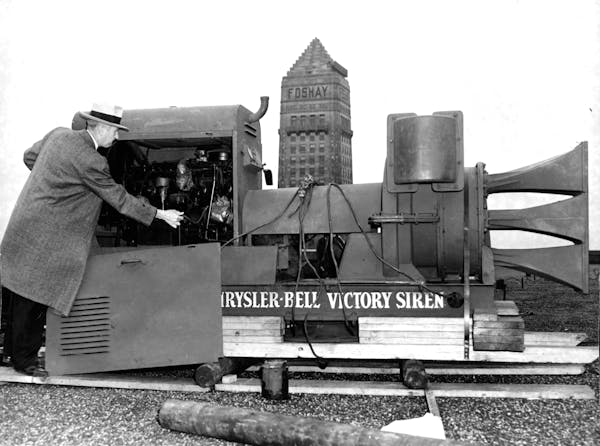Listen and subscribe to our podcast: Via Apple Podcasts | Spotify | Stitcher
The North Loop neighborhood, once a major manufacturing hub near downtown Minneapolis, has transformed into one of the city's most popular residential and entertainment destinations.
Drew Cove and a friend who lives in the neighborhood were at Fulton Brewing's taproom and started discussing how the North Loop got its name. "A loop" doesn't seem to appear anywhere in the area, so it bugged Cove for a long time, he said.
"I'm a big history and geography buff. I did some research, but couldn't find a definitive answer," he said.
Cove turned to Curious Minnesota, the Star Tribune's community reporting project fueled by great questions from inquisitive readers.
The term "Loop" originated in 1891 when the newly formed Twin City Rapid Transit required all streetcars serving downtown Minneapolis to travel a loop on Washington Avenue, 1st Avenue S. (now Marquette Avenue) and High Street (where the Main Post Office is today) and Hennepin Avenue to reach a central transfer station on Hennepin at 1st Street.
The Loop was created as part of a larger effort to institute a system of free transfers between streetcars, said Aaron Isaacs, who co-wrote the book "Twin Cities by Trolley" and oversees the Minnesota Streetcar Museum. Previously, passengers had to pay a new fare any time they transferred from one streetcar to another. This was a windfall for the streetcar company but the public hated it, he said.
In the mid-1880s both city councils passed free transfer ordinances, which the streetcar company stonewalled until 1891. Trying to minimize lost revenue and discourage transfer abuse, Twin City Rapid Transit created a Byzantine procedure which ultimately didn't work, said Isaacs.
Every streetcar was diverted around the Loop where all passengers wishing to transfer had to enter the transfer station. There they paid a nickel for a transfer, boarded whichever streetcar they were waiting for, presented the transfer and received a nickel refund, he said.
Not surprisingly, this was way too much trouble, added to travel time and created unforeseen delays when too many streetcars were trying to navigate the process. It was also costing the streetcar company a lot of money paying transfer agents and diverting their streetcars around the loop, he said. The cumbersome system was jettisoned in 1894. Other than streetcars from south Minneapolis terminating downtown, the diversion around the loop ended.
"However, the term 'Loop' stuck, and became a synonym for 'downtown,' " said Isaacs. "Any streetcar terminating in either downtown Minneapolis or downtown St. Paul carried a 'LOOP' destination sign."
After the streetcars were replaced by buses, the buses continued to carry "LOOP" signs until the new Metropolitan Transit Commission bought buses in 1971 with "Downtown" signs. The term "Loop" continues in use by Metro Transit staff as convenient shorthand for "Downtown."
"It's worth mentioning that the most famous use of loop refers to downtown Chicago, thanks to the well-known elevated rapid transit tracks opened in the 1890s that circle downtown to this day," he said.
The North Loop neighborhood is located in the Warehouse District, which is listed on the National Register of Historic Places. The North Loop is located northwest of the central business district between downtown Minneapolis and the Mississippi River. Streets in the North Loop are oriented to be parallel to the river, which means that they run at a 45-degree angle relative to the grid of the rest of the city.
From the late 1800s to the 1930s, the North Loop was the center of a wholesaling and manufacturing boom that turned Minneapolis into one of the key distribution centers in the United States, said Mike Binkley, volunteer writer for the North Loop Neighborhood Association. The city's expanding modern railroad system expedited business growth.
The district attracted national firms, including International Harvester, John Deere Co. and Ford Motor Co. The Milky Way candy bar was born in the North Loop in 1923 when Frank Mars and his son, Forrest, came up with an idea to create a candy bar that tasted like a malted milk shake, said historian Rolf Anderson, who authored the nomination for the Warehouse District's historical designation.
Besides being a significant business and milling hub, the Warehouse District made the historical registry in 1989 because of its architecture. Some of biggest designers in the state contributed to the area, including the architect of the State Capitol Building in St. Paul, and Lakewood Cemetery, Hennepin Avenue Methodist Church and the American Swedish Institute in Minneapolis.
When the Great Depression hit, the North Loop steadily declined as the companies that built the area began to disperse, Anderson said. The buildings sat vacant for decades, but at the turn of the century began to revitalize, with historic warehouses becoming housing and modern business centers, according to the North Loop's Neighborhood Association website.
More than 130 buildings remain in the district, some from 1865. As the North Loop continues to grow, Anderson hopes city officials continue to make preservation a priority. He cited the five buildings that were taken down when the Federal Reserve Bank was built.
The North Loop was described by Forbes magazine as "One of America's Best Hipster Neighborhoods." Fodors Travel Guide put the neighborhood on its 2016 list of 25 places in the world that avid travelers should check out.
If you'd like to submit a Curious Minnesota question, fill out the form below:
Read more Curious Minnesota stories:
How did Minnesota become the Gopher State?
Why is Uptown south of Downtown in Minneapolis?
Why is 'southeast' Minneapolis actually northeast of downtown?
What does ski-u-mah mean and how are you supposed to pronounce it?
What's the story behind the names of Pilot Knob, Johnny Cake and Yankee Doodle roads?
Why do so many Twin Cities mall names end in "dale"?





